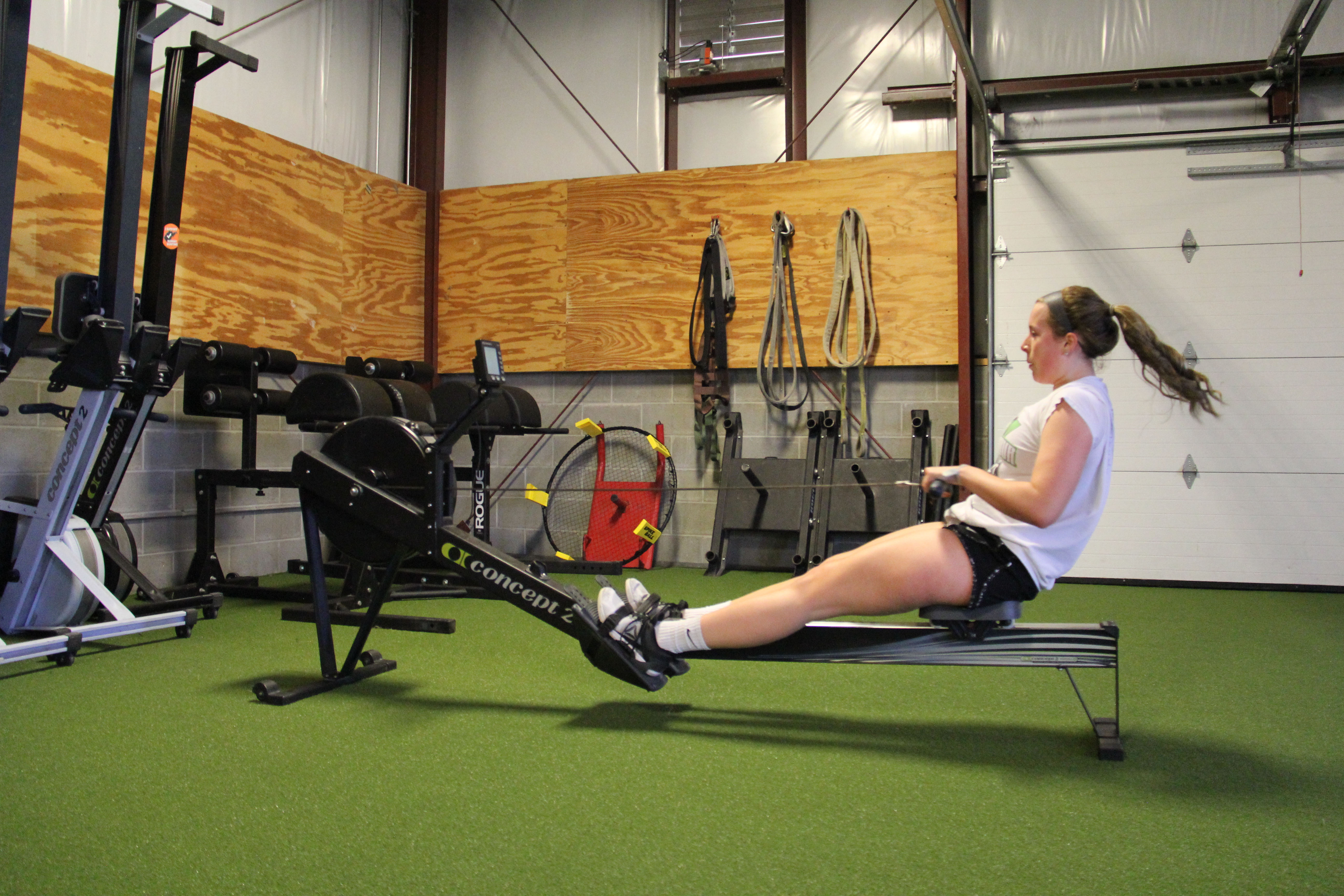Rowing In Your Strength Programs
Strength & ConditioningABOUT THE AUTHOR

Joe DeLeo
Joe DeLeo is a full time Strength & Conditioning Coach at Lawrence Memorial Hospital Performance & Wellness Center in Lawrence, Kansas. He coaches inside a sports performance and physical therapy clinic at Rock Chalk Park. He works with athletes returning directly from sports rehabilitation as well as athletes focused on performance in the sports of baseball, basketball, golf, soccer, swimming, track & field, and volleyball.
In October of 2018, Joe was named the Head Strength & Conditioning Coach for the Portuguese Rowing Federation.
// How to Incorporate Rowing into your Strength and Conditioning Programs
In the world of strength and conditioning, the “S” in the equation often gets most of the emphasis, while the “C” part can sometimes be relegated to an afterthought. While that’s hardly surprising given the need of athletes in the most popular American sports to pull off increasingly impressive feats of speed and power, it also leaves a lot of room for improvement on the endurance side.
Enter rowing, one of the most effective ways to improve conditioning, but also one of the most underrated modalities. To guide you on how best to incorporate rowing into your programming and explain how it can help your athletes, we called on Joe DeLeo, strength and conditioning coach at Lawrence Memorial Hospital Performance & Wellness Center in Lawrence, Kansas, who also performs that role for the Portuguese Rowing Federation.


Main Benefits of Rowing
The rowing machine allows you to do low impact, total body workouts. If someone has orthopedic issues or is coming back from injury, they can train their heart and lungs without having to worry about the pounding they’d get from running and other activities because rowing is a joint sparing activity. As it engages 80 percent plus of your muscles, it’s a very efficient and effective tool for both athletes and the general population. You can significantly improve your overall conditioning in as little as 20 minutes a day.
What to consider before Rowing
Athletes should work on the technical component because that will enable them to get the greatest benefits and avoid grooving faulty technique. Most of us learn how to swim, run, and ride a bike when we’re younger and do these things at some point as adults, but rowing isn’t taught to kids and isn’t quite as intuitive. We’ve seen it grow a lot through CrossFit, Orangetheory, and certain gyms, and now you have Hydrow, which is being seen as the Peloton of rowing machines. But it’s still a fairly niche modality. I suggest starting slow and steady for 10 minutes or so, and once you have your technique down, then starting to add time and speed.
How Coaches can Incorporate Rowing
Rowing allows coaches to develop different energy systems – alactic, aerobic, and anaerobic. It really depends on the needs of your athletes and what you want to target. For example, in baseball most plays last from zero to six seconds, and very few go beyond thirteen seconds. So if you’re training baseball players, you could have them mimic the demands of their sport and do five to 10 really hard strokes followed by 20 slow ones. This would stimulate the alactic system and develop explosive power. On the other hand, if you’re coaching athletes whose sport requires more sustained output, you could do longer sessions. Perhaps you’d have them do 250 to 500 meter intervals with a minute to 90 seconds active rest in between each.


How Rowing can help in contact Sports
Rowing allows you to directly address your players’ conditioning needs in a way that transfers to their on-field performance without them taking the pounding they would in full-contact practices. You get the benefits without the collision and potential trauma. Psychologically, the rowing machine enables you to train pain tolerance as you have to dig deep when you start feeling muscular burn and have to keep your breathing under control even when you’re starting to fatigue. You can also create a competitive training environment by putting rowing machines side by side and having athletes race each other. Every stroke you’re getting instant feedback and knowing what your output is, so you get both that qualitative piece and quantitative data as well.
Advantages for Endurance Athletes
Swimmers and cross-country skiers would benefit from rowing for several reasons. First, it gets them out of their typical positions that they spend hours in each week. For swimming, you’re taking an overhead athlete and training them horizontally, which will be good for their shoulders. And while cross-country skiers will still be hip hinging, they’re seated instead of standing, opening their hips up in a different way, and pulling instead of pushing with their poles. In the off-season, a swimmer could do three days in the pool and then add a rowing piece onto the end of two strength training sessions in the gym. Using a different modality and motor pattern doesn’t just lower repetitive stress and offer a new physical challenge, but also provides a mental break from the same old activity. That way when the athlete returns to their usual routine, they’ll be fresh and raring to go.


How Sympathetic Dominant Athletes Can Benefit from Rowing
If someone is really type A and likes to hit it hard every day, they could definitely benefit from doing some slower, more controlled pieces on the rowing machine. In fact, the meditative component is one of the biggest reasons I still love to row. In this case, I’d have them use a heart rate monitor and utilize the Maffetone Method of 180 – age to keep their intensity level low. I’d also suggest changing the monitor display so it shows watts instead of 500-meter split time, as this type of athlete will easily fall back into the trap of going all out if they’re trying to beat their last split. If all you do is high intensity training, you’re priming your body to burn through glycogen. Whereas if you can add in some more aerobic work, you’ll begin to better utilize fat as a fuel source. There’s a reason that the aerobic system is the biggest in the body. We know that we’ve only got a maximum of 2,000 calories that we can take from glycogen stores before we bonk. Whereas fat can keep us going a lot longer. So if you can train your body to tap into this, you will become more efficient in utilizing your different energy, which will make you more resilient in competition.
Takeaways from the Portuguse Rowing Team
They do up to 20K on the water with their heart rate between 140 and 150 beats a minute and with their blood lactate very low – around 1.2 to 1.5 mml. If you’re patient, over time you will become able to buffer lactate and process it even when operating at high intensity. That’s one of the benefits of doing steady state aerobic work regularly. This type of training also helps to combat the oxidative stress and damage that can lead to fatigue and burnout. In the off season, the rowers do what I suggested for skiers and swimmers earlier – they cross-train on different modalities so they’re still training their aerobic system, while giving their bodies a break from the rowing motion.
// Sample Rowing Workouts
Joe kindly provided us with some sample workouts that you can plug into your athletes’ programming to develop everything from power, speed, and explosiveness to sustained output.
Your Title Goes Here
Your content goes here. Edit or remove this text inline or in the module Content settings. You can also style every aspect of this content in the module Design settings and even apply custom CSS to this text in the module Advanced settings.
Glycolytic Training (Heart rate at max, 95 to 100% intensity)
1) (7 x 1 minute hard, 1 minute easy) x 2 or 3
2) 4 – 8 x 500 meters, with three to four minutes rest between each piece
Alactic Intervals (Heart rate 170 to 190 bpm, 85 to 95% intensity)
1) 10 seconds ON Full Pressure, 50 seconds OFF (easy paddle) x 10-12 minutes
2) Minute 1: 10 seconds ON, 50 seconds OFF (easy paddle)
Minute 2: 12 seconds ON, 48 seconds OFF (easy paddle)
Minute 3: 15 seconds ON, 45 seconds OFF (easy paddle)
Repeat Minutes 1-3 x 3, then take 1 minute OFF completely.
Steady State Work (Heart rate 140 to 165 bpm, 65 to 80% intensity); Use Maffetone Method (180-Age)
1) 40 to 60 minutes continuous at 18-22 strokes per minute
2) 2 x 20 minutes at 18-22 strokes per minute, with 2 minutes rest between each set
READY TO TRY TRAINHEROIC?
Our powerful platform connects coaches and athletes from across the world. Whether you are a coach or trainer looking to provide a better experience for your clients, or you’re an athlete looking for expert programming, click below to get started.
Want more training content?
More coaches and athletes than ever are reading the TrainHeroic blog, and it’s our mission to support them with the best training & coaching content. If you found this article useful, please take a moment to share it on social media, engage with the author, and link to this article on your own blog or any forums you post on.
Be Your Best,
TrainHeroic Content Team
HEROIC SOCIAL
HEROIC SOCIAL
TRAINING LAB
Access the latest articles, reviews, and case studies from the top strength and conditioning minds in the TH Training Lab

